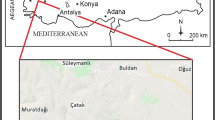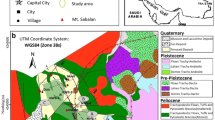Abstract
Esenyurt District of Istanbul Province is one of the important locations of the region in terms of geothermal energy potential. In this context, a geothermal resource determination study was carried out to increase the site’s geological and hydrogeological knowledge. As a result of geological investigations, in the Paleozoic sequence, the effect of the North Anatolian Fault zone existed in all periods. NE-SW directional compressions have folded basement rocks. Especially terrestrial and lagoon sediments deposited in the region, where the basin was formed in the upper Miocene, have been folded and fractured due to the deformations of the North Anatolian Fault Zone. The claystone levels in the flood plain and lacustrine deposits show adequate cap rock features at the strata. The Eocene limestones are determined as reservoir rocks of the field according to these geological characteristics. The low temperature, flow rate, and chemical composition changes of the fluid revealed that the field has a low enthalpy and a long water circulation period due to characteristics of faults and fractures. In the study area, data from two wells were evaluated for the two geothermal fields named Kıraç and Saadetdere. For the Beytepe thermal well drilled in the Kıraç region, the flow rate has been measured as 6 lt/s with a temperature of 35 °C. The pH value has been determined as 7.49, and the EC value has been measured as 7680 μS/cm. The class of the water is NaCl. The total dissolved solid value is 4527.940 mg/L. The depth of the Saadetdere well of only the Saadetdere field was 1200 m. The fluid temperature has been measured as 49 °C, and the flow rate has been determined as 15 lt/s. The total dissolved solid value of the fluid has been 37,248 mg/L. The class of the water is also NaCl. As a result of the geological, geophysical, and hydrogeochemical studies executed within the scope of this study, two new geothermal fields have been discovered in the Esenyurt district.
Access provided by Autonomous University of Puebla. Download conference paper PDF
Similar content being viewed by others
Keywords
1 Introduction
Esenyurt District of Istanbul Province is one of the important locations of the region in terms of geothermal energy potential. In addition, the district of Esenyurt, with a population of approximately 1 million, has a larger population than many other provinces in Turkey. Therefore, the need for hot and cold water is increasing daily. In this context, a geothermal resource determination study was carried out to increase the site’s geological and hydrogeological knowledge. The study area is located on the European side of the province of Istanbul and covers the area between Büyükçekmece Lake and Esenyurt.
This study aims to investigate geothermal resources with water chemistry and field geology assistance. The physicochemical water analyses of the water samples taken in the study were evaluated, and the rock-water relationship was interpreted. As a result, the low temperature, flow rate, and chemical composition changes of the fluid revealed that the field has a low enthalpy and a long water circulation period due to characteristics of faults and fractures.
2 Geological Background and Hydrogeology
In geological studies, sedimentary rock groups formed in the Oligocene and Miocene periods in a vast region in the study area and its surroundings. Paleozoic basement rocks are mostly located in N-NE and N-NW directions. While Istanbul Paleozoic sediments are located in the NE of the region that includes the study area, the metamorphic rocks of the Strandja massif are spread over a wide area in the NW of the region. The sedimentary rocks of the Istanbul Paleozoic sequence and the metamorphics of the Istranca massif are separated by a fault plane called the West Black Sea fault in the N-NW of the study area. All Neogene and post-Neogene deposits cover this fault plane. It is also known that Eocene limestones exist under the Oligocene–Miocene age sedimentary rocks.
The carboniferous rock unit Trakya Formation is characterized by graywackes located at the region’s bottom of the strata. Eocene-aged limestones overlie these units. The upper Oligocene unit Gürpınar Formation has a lithology consisting of greenish-yellowish colored clay, silt, and clayey siltstones (Sayar, 1979). Intermediate layers of siltstone, pebbly sandstone, and tuff are found between the clayey levels. The average thickness of this formation is about 200 m. The Çukurçeşme Formation, which spreads over a wide area in the study area and its vicinity, is mainly composed of sand and a small amount of gravel. The gray–greenish gray-colored and parallelly laminated clays overlying the Çukurçeşme Formation are named as Güngören Formation. Clays in which locally very well-sorted gray-colored fine sand lenses and green-colored marl interlayers are found at most 120 m reaches thickness. At the top of these units, the Bakırköy Formation, which consists of units in which reef and front reef clastic rocks are observed intermittently, is represented mainly by mactra limestones containing clay and marl interlayers. This formation has an average thickness of 30 m and is covered by younger sediments. In addition, alluvial deposits in stream beds, filling materials, and landslide complexes in different regions have been reported (Fig. 1).
Geological map of the study area (Yurtsever, 1996)
The region’s Miocene sedimentary sequence consists of general impermeable, non-reservoir lithologies. Due to these features, it does not carry groundwater. However, sandy and gravelly levels in this clayey, silty sequence carry water in their structures when they are in good contact with the surface and feeding areas. If drilling is done from these zones, yields of 1–3 L/s flow rate can be obtained. Kırklareli formation, under the Miocene sediments, has a limestone lithological character. There is advanced karstification in the reef limestones in it. It is a regionally good deep reservoir rock. Due to young tectonism and young faults in the study area, this deep reservoir is warming up in areas with high geothermal gradients. Drilling data in the Harmidere and Kıraç fault zones reveal this result. In geophysical measurements made in the license area, geothermal heating is expected in low-resistivity deep zones.
3 Results
The physicochemical water analyses of the water samples taken in the study were evaluated, and the rock-water relationship was interpreted. According to the water chemistry analysis of the Kıraç Beytepe thermal well, the well is classified as a thermo mineral water with sodium chloride. If the amount of salt is above the threshold value determined for salty waters, it is also included in the group of salty waters. Sulfur and fluoride values are also above the threshold value. According to the Piper and Schoeller diagrams, the water is classified as NaCl and included in the salty and soda waters class. Saadetdere water sample has the characteristics of thermomineral Water, in general with its properties. Due to the amount of Na and Cl in its content, it has the quality of “saltwater”. According to the Piper and Schoeller diagrams, the water is also classified as NaCl class (Figs. 2 and 3).
To use cation geothermometers for determining reservoir rock temperatures, chemical analysis results were evaluated in the Giggenbach (1988) Na–K–Mg diagram. Briefly, the diagram consists of three parts: water where the water–rock relationship is not in equilibrium (raw waters), the water–rock relationship is partially in equilibrium (mixed waters), and the water–rock relationship is in full equilibrium. According to the Giggenbach diagram, both samples are in the class of nonequilibrium (raw waters) waters (Fig. 4).
4 Conclusion
Due to the constantly increasing population, the need for hot and cold water in the Esenyurt district is also increasing. For this reason, various hot water exploration activities are carried out. This study emphasizes the hot waters determined as a result of these activities. According to the geological studies and water chemistry analysis, the field has a low enthalpy and a long water circulation period due to characteristics of faults and fractures. As a result of the geological, geophysical, and hydrogeochemical studies executed within the scope of this study, two new geothermal fields have been discovered in the Esenyurt district.
References
Giggenbach, W. F. (1988). Geothermal solute equilibria. Derivation of Na-K-Ca-Mg Geoindicators, Geochim. et Cosmo. Acta, 48.
Sayar, C. (1979). Ordovician—Silurian boundary in and around the Bosphorus: Turkiye Geo. Bult., 22, 161–167 (In Turkish).
Yurtsever, A. (1996). Geology of the Istanbul Peninsula (1/50,000 scale map). MTA Rep. No. 9989, Ankara (In Turkish).
Author information
Authors and Affiliations
Corresponding author
Editor information
Editors and Affiliations
Rights and permissions
Copyright information
© 2023 The Author(s), under exclusive license to Springer Nature Switzerland AG
About this paper
Cite this paper
Gözübol, A.M., Beren, M., Hoşgörmez, H., Özcan, D. (2023). Evaluation of the Geothermal Resources of Esenyurt District (Istanbul). In: Chenchouni, H., et al. Recent Research on Hydrogeology, Geoecology and Atmospheric Sciences . MedGU 2021. Advances in Science, Technology & Innovation. Springer, Cham. https://doi.org/10.1007/978-3-031-43169-2_32
Download citation
DOI: https://doi.org/10.1007/978-3-031-43169-2_32
Published:
Publisher Name: Springer, Cham
Print ISBN: 978-3-031-43168-5
Online ISBN: 978-3-031-43169-2
eBook Packages: Earth and Environmental ScienceEarth and Environmental Science (R0)








